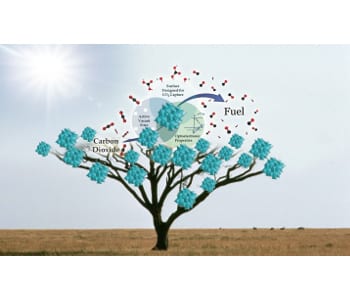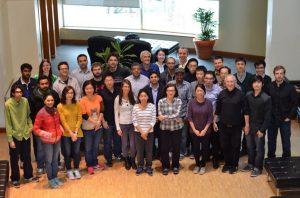Editors’ note: When we first asked Professor Ozin to contribute to MaterialsViews, back in 2010, we were all delighted by the outcome – his first article, “The Good Nano Stuff: Where Is It Going?“, immediately inspired debate both in and out of the office, and went straight to the top of our download charts. Even now it still appears as a regularly accessed feature! I’m not sure any of us thought so far ahead to expect to be celebrating 50 articles five years later, but in that time Professor Ozin has provided some of the most popular, thought-provoking, and downright interesting pieces that we have published. The contribution below is number 50, but once you’ve finished why not check out his archive page to see some of the highlights from the past five years, including prescient thoughts on energy nanomaterials, research inspired by nature and natural phenomena, our ongoing war – and chances for peace – with that industrial and environmental pesky molecule CO2, and much more. I know all of us would like to thank Geoff for his great contribution since 2010, and we all look forward to the next 50! — Adrian Miller, Managing Editor, MaterialsViews
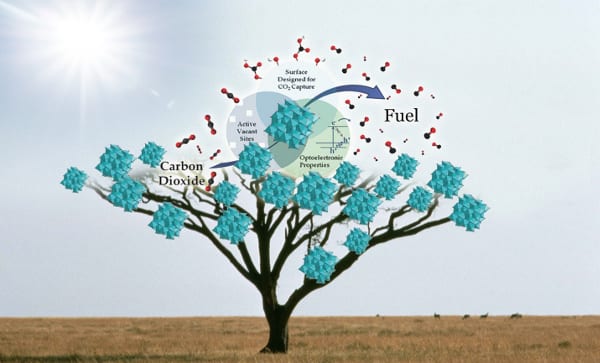
Solar fuels tree. Graphic courtesy of Chenxi Qian.
Golden Opportunity
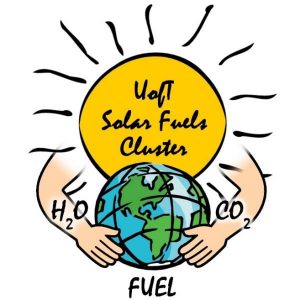
University of Toronto Solar Fuels Cluster – Solar Fuels from the Sun, Not Fossil Fuels from the Earth. Graphic courtesy of Chenxi Qian.
After more than 45 years of research in the field of materials chemistry I was given the interesting opportunity in 2010 to write invited monthly opinion editorials for the MaterialsViews website, part of the Wiley family of materials journals. This invitation from the editor of Advanced Materials, Peter Gregory, provided me with a superb and irresistible vehicle to express opinionated and provocative views about hot button issues in materials chemistry, my major field of interest.
I must confess that dreaming up and composing these editorials has been a valuable lesson in how to write scientific and technological critiques about timely and controversial topics for a public forum, a pastime less risky for a senior scientist, such as myself, than a junior one. I hope the readers have enjoyed these editorials as much as I had fun writing them.
After having produced 49 of these opinion editorials on a variety of contemporary topics, the collection of which can be found here. I thought it worthwhile and exciting for my 50th to compose a Golden Anniversary editorial about my current all-consuming passion – the creation, mission and activities of the University of Toronto Solar Fuels Cluster that I have had the good fortune to be able to spearhead over the past three years.
An Important Historical Note
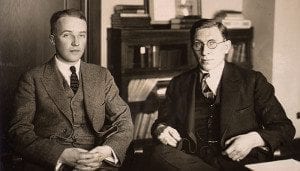
1923 Nobel Prize for the discovery of insulin, Banting and Best, University of Toronto.
The discovery of insulin by Banting and Best at the University of Toronto as a cure for diabetes in 1921 is hailed as one of the biggest discoveries in medicine, saving the lives of millions of people around the world suffering from this life threatening disease. This miracle breakthrough was recognized by the Nobel Prize in Physiology or Medicine in 1923 for its UofT inventors. Income from the manufacture and commercialisation of insulin has been used by the UofT to fund leading-edge research under the auspices of the Connaught Fund, which rewards research that meets society’s challenges.
Recently they created a $1M Connaught Global Challenge Award to expand and enrich research directed at grand challenges of global importance to humanity. The UofT Solar Fuels Cluster are the 2015 recipient of this prestigious award for their project, The New CO2 Economy – Solar Energy Enabled Closed Carbon Cycle.

Illuminations on the utilization of CO2: the illustration depicts the grand challenge that the global community must confront in the face of CO2 induced climate change in order to achieve a sustainable environment, a renewable energy supply and a carbon neutral economy. Graphic courtesy of Chenxi Qian.
The parallels between these seemingly different scientific challenges are rather poetic. Insulin enables the body to convert and store blood sugar as a fuel to provide energy on demand; while the natural process of photosynthesis converts and stores sunlight energy in the form of sugars produced from CO2 and H2O, which energize plants and ultimately produce the fossil energy our global society currently depends on. Our mission is to convert and store sunlight energy in synthetic Solar Fuels produced from CO2 and H2O, which could help end our dependence on fossil energy and solve the intertwined climate, energy and environment problems confronting humanity today. Just imagine how sweet it is!
Challenge
While the stored chemical energy in coal, oil and natural gas has enabled the rapid rise of modern civilization, the burning of these legacy fossil fuels with its accompanying anthropogenic CO2 emissions is occurring at a rate that is outpacing nature’s carbon cycle. The effect of these emissions is now considered by the Intergovernmental Panel on Climate Change[1] to be high to very high risk and could lead to a rapid and massive upheaval of human society unless a global scale solution to the intertwined effects of fossil fuels, energy security, environmental protection and climate change is found. In this context, a recent modeling research study concluded that most of the world’s fossil fuel reserves need to stay in the ground over the period 2010-2050 to not exceed the 2°C warming limit and avoid the risk of dangerous global warming.[2] Clearly, climate change is a complex technological, environmental, societal, economic and political issue without a simple solution.
To address this challenge, the UofT Solar Fuels Cluster, as well as many other talented researchers and top rank groups around the world, are targeting innovative technological solutions that focus on the capture and conversion of CO2 into renewable fuels using sunlight as the energy source, H2O and/or H2 as the co-reactant. This transformative research paradigm treats CO2 as a renewable resource rather than a waste product, turning CO2 from a liability to an asset, thereby providing a chemical platform for developing a carbon-neutral CO2 economy that can enable a sustainable future for humankind. Progress of research in this area is gathering momentum and will probably continue to do so for the foreseeable future.
It is worth commenting that in this endeavor there exist two schools of thought: (i) an aqueous process, which is likened to artificial photosynthesis practiced by the leaf, with more than four decades of research activity aimed at developing laboratory scale mimics and ultimately scale-up and (ii) a gas-phase process, which is more akin to heterogeneous photocatalysis, of a more recent vintage that more closely resembles heterogeneous catalysis practiced by industry. The latter approach is the main focus of attention of the UofT Solar Fuels Cluster.
UofT Solar Fuels Cluster
This multidisciplinary team of accomplished academic researchers and budding young scientists have collectively risen to the grand challenge of discovering new materials and processes that can enable solar powered heterogeneous catalytic conversion of gaseous CO2 to value-added chemicals and fuels. The team comprises the full spectrum of materials chemists, materials scientists and engineers, chemical engineers, and electrical and optical engineers. Between them they have the combined experimental and theoretical expertise to achieve the following:
- synthesize photoactive nanostructured materials;
- determine their structures and measure their properties;
- computationally model and guide experiments on light-assisted heterogeneous catalytic conversion of CO2-to-Fuel; and
- design and build photoreactors to evaluate the catalytic performance of photoactive materials for the conversion of gaseous CO2 to chemicals and fuels using sunlight as the source of power.
Talent Pool
Another important target for the UofT Solar Fuels Cluster is the recruitment and training of highly qualified personnel, who will not only contribute actively to the solar fuels research program, but who will consequently begin to grow a unique solar fuels renewable energy talent pool, as the cornerstone of a new global cleantech subsector in conversion of CO2 to chemicals and fuels.
The Cluster and Industry Partners
The long term objective of the research of UofT Solar Fuels Cluster is to function as a hub for a global network of solar fuels scientists, engineers and industry partners. The network we have built encompasses nationally and internationally renowned scientists, engineers and economists, working in fields that include:
- photochemistry and photoelectrochemistry of nanoscale inorganic materials directed towards the generation of solar fuels;
- design of solar fuel materials tailored to catalyze specific reactions by combining high-performance computation with precise synthetic chemistry;
- development of theory, models and algorithms for the solution of fundamental and practical problems in the area of solar fuels process development, assessment and production; and
- environmental economics and emissions trading aspects of climate change and renewable energy.
The UofT Solar Fuels Cluster will deepen collaborations with national and international industry partners, the ultimate goal being to facilitate the transition of laboratory-scale solar fuels experiments to a prototype pilot demonstration unit that will be instrumental for the development of an efficient and scalable technology to provide future generations with sustainable solar chemicals fuels using CO2 as feed stock.
As the collaboration with Industry Partners progresses, the UofT Solar Fuels Cluster and our Industrial Partners will also need to communicate to politicians and governments the viability of this CO2-to-fuel conversion strategy and to persuade them to adopt it as a goal. At the same time, the public should be informed and educated that this strategy is a viable economic and environmental solution to reduce greenhouse gases.
Advances and the Future
During the first three years of their solar powered CO2-to-Fuels research, the “evolutionary” phase, the UofT Solar Fuels Cluster have identified a promising series of nanostructured solar fuel materials, and developed appropriate research methodologies and established the instrumental facilities for their structure characterization, property measurements and catalytic testing.[3-7]
Today, champion rates for light-assisted conversion of gaseous CO2 to hydrocarbon fuel molecules achieved by the UofT Solar Fuels Cluster are within an order of magnitude of the mol/h∙gcat target rate. Based on these advances it is envisioned that with continued research and development, fuels made in a solar refinery could gradually replace those produced in a refinery powered by fossil fuels.[8]
The UofT Solar Fuels Cluster and their collaborators will now be involved in major activities aimed at expanding upon and enriching the accrued knowledge of published and patented work gained by the cluster during the evolutionary phase to transition it to the revolutionary phase, aimed at a solar fuels technology.[3-7] In this “revolutionary” phase of the research, the goal is to build upon the basic materials science and engineering experiences they have gained for solar powered conversion of gaseous CO2 to fuels, to combine materials and processes that can achieve technologically significant conversion rates of mol/h∙gcat. The target is the discovery and development of earth-abundant, low-cost materials able to effectively harvest sunlight, capture CO2 and efficiently drive a cost-effective gas-phase heterogeneous photo-catalytic CO2 conversion process in a solar refinery to form a transportable fuel at a technologically significant rate.
To this end, the focus of their continuing research will be on the discovery of next generation solar fuel materials, through both experimental and theoretical methods, and development of new and improved photo-reactors and processes. This continuing research will comprise:
- discovery, structure determination and property measurements of nanostructured materials active for light-assisted, gas-phase CO2 photoreduction;
- evaluation of conversion rates and efficiencies for production of solar fuels, such as CO, CH4, CH3OH by light-assisted, gas-phase heterogeneous catalytic reduction of CO2; and
- experimental and computational studies of surface chemistry, energetic, kinetics and mechanisms pertinent to these photoreactions.
These studies will be complemented by:
- optimization of materials catalytic performance;
- developing material fabrication technologies for scaling;
- development and testing of prototype pilot photoreactors;
- evaluation of solar concentration on CO2-to-Fuel conversion rates, efficiencies, mass and energy balance; and
- life cycle process modeling to assess material, energy and economic flows and hence the feasibility of making a solar fuels production facility from CO2 for the most active materials.
CCEMC Grand Challenge – Innovative Carbon Uses
In 2009 the Alberta based Climate Change and Emissions Management Corporation (CCEMC) was established to reduce greenhouse gas emissions and help Alberta adapt to climate change through the discovery development and deployment of clean technology. CCEMC was created as a key part of Alberta’s Climate Change Strategy and movement toward a stronger and more diverse lower-carbon economy. CCEMC have issued a Grand Challenge to the science and engineering research community around the world to devise innovative materials and processes that can enable the conversion of CO2 emissions into value-added products and markets . Funding of $35M has been committed by CCEMC in a three stage competition to achieve this goal.
Round 1 attracted 347 submissions from 37 countries and seed funding of $500,000 was awarded to 24 projects based on their chances of success in achieving this objective. Round 2 has recently been announced (closes January 2016) and a second world wide intake on technologies is being considered along with advancements of the original 24. Five development grants each of $3M will be awarded for projects that can demonstrate annual net reductions of greenhouse gas emissions of 1 net Megatonne together with a viable business plan for implementing and deploying the technology in Alberta. In the final Round 3, an award of $10M will be made to a demonstrated technology able to yield products that result in a net reduction of greenhouse gas, and is judged to be scalable and economically viable and is best positioned for commercial deployment. .
Carbon XPRIZE – Reimagining CO2
A $20 Million carbon XPRIZE sponsored by NRG COSIA is a global competition challenging scientists and engineers to develop disruptive technologies that will convert CO₂ emissions from power plants and industrial facilities into valuable products like building materials, alternative fuels and other items that we use every day.
Teams will compete in three rounds for $20 million. The competition has two technology tracks one involving the development of a test platform at a coal power plant and the other at a natural gas power plant. Each will operate as a separate competition on the same timeline. Teams in Round 1 will be appraised on technical and business information concerning the technology, process, products, and implementation to achieve the practical requirements and defined goals of the competition. Up to 15 teams in each track will move onto Round 2 with a focus on technologies that meets minimum CO2 conversion requirements in a laboratory demonstration. Five teams selected for Round 3 will share a $2.5M milestone achievement purse. The grand challenge is to scale and demonstrate the effectiveness of technologies working with real-world flue gas emitted by operating power plants. The technology that wins the $7.5M grand prize will have to achieve performance metrics based on a minimum CO2 conversion rate of 200 kg/day (4,600 moles/day) using a maximum land area of 2,300 m2.
Challenge Perspective
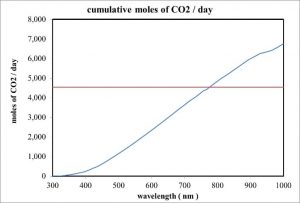
The carbon XPRIZE challenge for solar powered conversion of CO2-to-CH3OH, courtesy of Tom Wood.
Let’s imagine targeting solar powered conversion of CO2-to-CH3OH, a reaction which consumes 6 e– for each molecule of CO2 converted assuming a conversion efficiency of 10% and 8 hours of operation each day. The analysis involves determination of the number of photons per m2 to provide the number of CO2 molecules converted per m2 which provides the daily conversion of CO2. One arrives at the conclusion that to win the carbon XPRIZE, one would need to make use of harvested light up to 780 nm as seen in the plot of cumulative moles of CO2 converted per day as a function of wavelength.
Imagine the bounty of new materials we can create by optimally harvesting light in the same effective and efficient way nature does to sustain its world of energy systems. We already have the key knowledge and applied know-how we need to make continuous breakthroughs that can advance everything from solar electricity to fuel cells to battery power. Virtually everything we need for creating a sustainable future is within our minds and fingertips that control our most ingenious technology to this end. We now simply need to work together in grasping the CCEMC Grand Challenge and Carbon XPRIZE and realizing the potential of the NanoAdvantage!
Acknowledgements
GAO is Government of Canada Research Chair in Materials Chemistry and Nanochemistry. Financial support for this work was and continues to be provided by the Ontario Ministry of Research Innovation (MRI); Ministry of Economic Development, Employment and Infrastructure (MEDI); Ministry of the Environment and Climate Change; Connaught Innovation Fund; Connaught Global Challenge Fund; Natural Sciences and Engineering Research Council of Canada (NSERC).
References
1. www.ipcc.ch/.
2. J. M. Hilaire, Nature, 2015, 517, 10.
3. L. B. Hoch, T. E. Wood, P. G. O’Brien, K. Liao, L. M. Reyes, C. A. Mims, G. A. Ozin, Advanced Science, 2014, DOI: 10.1002/advs.201400013.
4. P.G. O’Brien, A. Sandhel, T. E. Wood, A. Jelle, L. B. Hoch, C. A. Mims, G. A. Ozin, 2014, Advanced Science, 2014, DOI: 10.1002/advs.201400001.
5. G. A. Ozin, Advanced Materials, 2015, DOI: 10.1002/adma.201500116.
6. K. K. Ghuman, T. E. Wood, L. B. Hoch, C. A. Mims, G. A. Ozin, C. V. Singh, Physical Chemistry Chemical Physics, DOI: 10.1039/c5cp02613j.
7. G. A. Ozin, Energy and Environmental Science, 2015, DOI: 10.1039/c5ee00907c.
8. Herron, J.A., Kim, J., Upadhye, A.A., Huber, G.W., Maravelias, C.T., Energy and Environmental Science, 2014, DOI: 10.1039/c4ee01958j.

